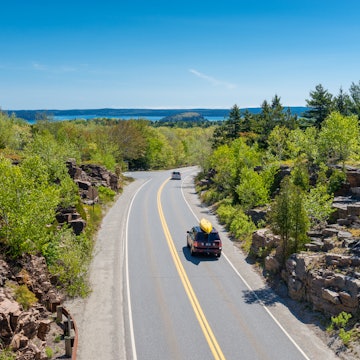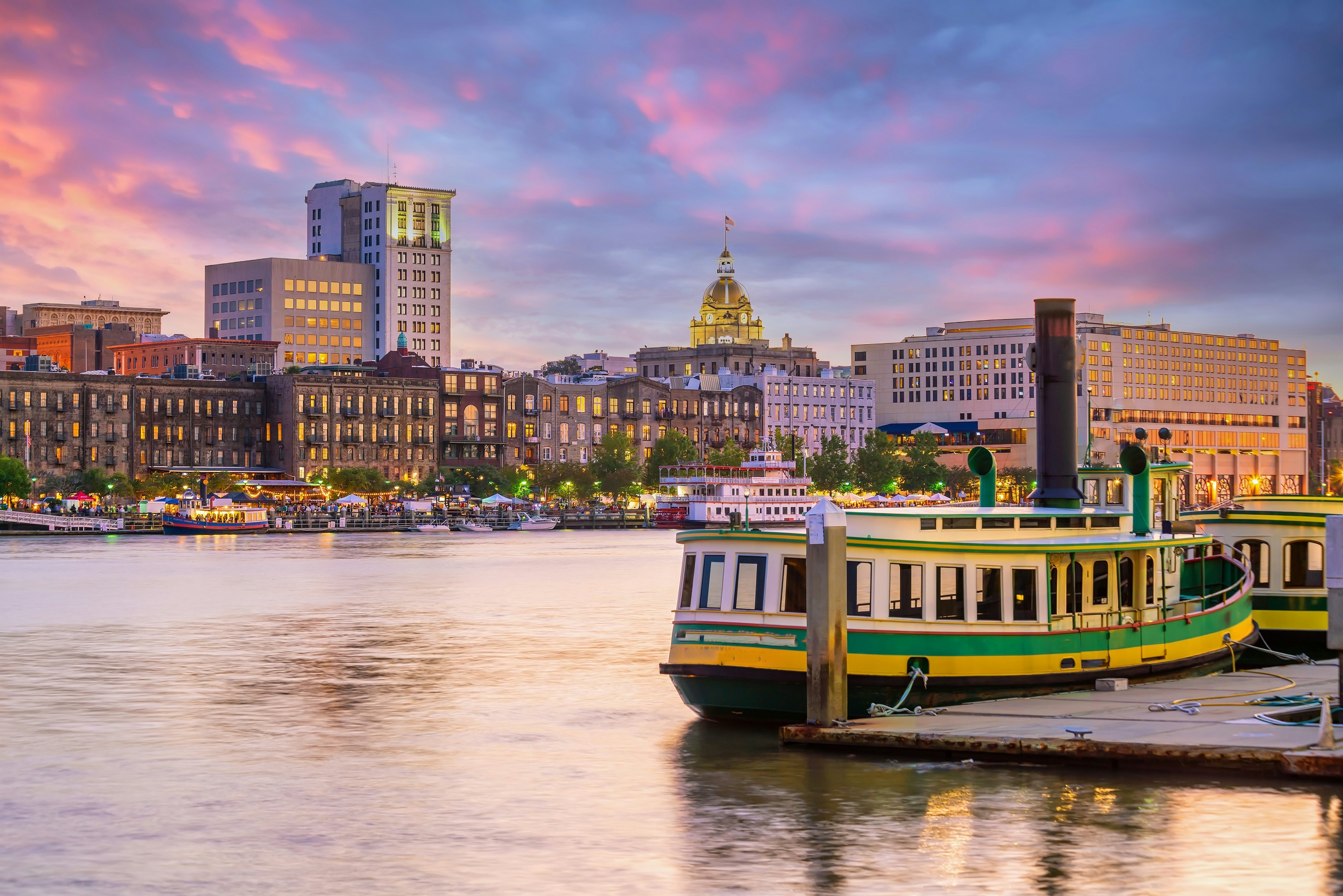

From walking through its historic squares to riding the ferry, here are Savannah's best free experiences. Photograph: Hunter McRae
Brimming with Southern hospitality from every corner of its many squares, there is nothing more indicative of Savannah's generosity than the friendliness of its residents (and its free attractions). Together, these sites offer a thorough view into the area’s history, culture, economic significance and transformation – and at no charge.
Whether you choose to walk, weave or ride the waterways through the Hostess City, you are bound to find ways to stay entertained and informed without spending a single penny. Here are the best things to do in Savannah for free.

1 . Travel through time walking Savannah’s historic district
The cast metal and marble monuments that serve as the focal point of the city's squares could be considered mile markers along Savannah’s historical roadmap. From the granite boulder marking the resting place of Savannah’s earliest settler, Yamacraw Chief Tomochichi, to the bronze figures of Haitian soldiers honoring the revolutionary volunteers who fought the British at the Siege of Savannah, each statue pays tribute to a brave leader or troop who has shaped the city’s story in some way.
If you weave your way through the streets starting from Johnson Square, the oldest square in America’s first planned city, to the Civil War Memorial at Forsyth Park, you’ll pass symbols marking about two centuries' worth of events. Catch vestiges of Savannah’s early settlement by founder James Oglethorpe, colonial red-brick paving along Jones Street, and the Green-Meldrim House that served as a sanctuary for Union General William Sherman during the Civil War.
2. Learn through the landmarks of the old town by free trolley
Hop onto one of the garish grape-purple and green trolleys that twist through about 20 notable spots across the historic district. Visitors can hop off at any of the stops located at or within walking distance of some of the city’s major cultural attractions, including the birthplace of Juliet Gordon Low (founder of the Girl Scouts); the Girl Scouts’ first headquarters; the Savannah College of Art and Design, which owns more than 100 of the city’s buildings; and the First Baptist Church, one of few edifices in the city to survive its many fires because, unlike others, the building was made of concrete.
Planning tip: The dot Express Shuttle serves as free city transportation rather than a tour bus, so you can alight whenever you want.

3. Promenade the riverfront boardwalk
Savannah is surrounded by swampy, coastal marshlands, so heat and humidity prevail during most parts of the year. However, every now and then, one can catch a breeze along the riverwalk while gazing at the galleries and shops that line the way. Clothing and beauty boutiques, restaurants, specialty food stores and markets abut the waterfront leading all the way up to the Plant River District, a restored 1912 power plant that now whirs to life with concerts, dining and nightlife in the evenings. Strolling along the riverfront, you’ll pass landmarks of 20th-century history: the African American monument and the bust of Civil Rights leader and Nobel Laureate Martin Luther King, Jr.
Local tip: Martin Luther King, Jr.'s Emancipation Day Address, delivered while he visited Savannah in 1961, is etched into the pedestal holding his bust.
4. Celebrate African cultures at the Savannah African Art Museum
One of the few museums in town to offer free admission, this gallery features a collection of art and artifacts from West and Central Africa across 28 countries and 180 cultural and ethnic groups, including those that have influenced the history, culture and flavors of Savannah. The Savannah African Art Museum celebrates the people and traditions of those regions. Wooden figures carved by people of the Lobi culture, thrones and sculptures from Cameroon, and Mukenga masks woven from a variety of textiles and inlaid with beadwork are displayed at the exhibits, and special workshops have been hosted on the impact to the Igbo people of Nigeria as a result of enslavement.
5. Float the Savannah River on a ferry named after famous women
Bob along the Savannah River from the downtown riverwalk to Hutchinson Island. From the ferry, you’ll catch views of Savannah’s riverside, which glitters at night once the city is illuminated and reflected in the waters. Like the trolley, the Savannah Belles Ferry (not to be confused with the Southern Belle Riverboat) shuttles commuters to three popular spots for free: City Hall Landing, Trade Center Landing and the Waving Girl Statue.
Each of the four boats in the ferry’s fleet honors historic women of Savannah: Juliette Gordon Low, founder of the American Girl Scouts; Susie King Taylor, a formerly enslaved woman who started one of Savannah’s first schools for African-American children; Florence Martus, the waving girl, who greeted ships entering Savannah with the wave of her cloth for more than 40 years; and Mary Musgrove, a Native American who helped with interpretation and negotiation between Savannah’s earliest settler, Yamacraw Chief Tomochichi, and the city's founder, James Oglethorpe.

6. Tour Savannah’s historic places of worship
The milk-white towers of the Cathedral Basilica of St John the Baptist hover above most of historic Savannah, making this Catholic church one of the most iconic sites in the city. Its blue spires topped with gold crosses are visible from many parts of downtown, beckoning visitors as it once did immigrants fleeing Haiti and France. When a service isn’t being conducted, visitors can walk inside the basilica for free to view the grandeur of the lavishly decorated vaulted ceilings, marble pillars and stained-glass windows.
Although James Oglethorpe founded Georgia as a settlement strictly forbidding Catholicism, he eventually had to open doors to other religions. Initially, he feared that if Catholics placed roots in Georgia and conflict ensued between Spanish and English forces, Catholic residents would sway pro-Spanish. When bouts of illness ravaged through the early settlements, Oglethorpe welcomed the help of Jewish doctor Samuel Nunez and eventually allowed Jewish settlers to own land and establish the Temple Mickve Israel, the oldest Jewish congregation in the South.
7. Experience a feast for the senses at Savannah Botanical Gardens
Vibrant blossoms burst open amidst the natural and formal arrangements at Savannah Botanical Gardens. The public areas of the garden are free to access, so sit back on a butterfly bench and breathe in the fragrance of English roses. Look for ferns creeping along cobbled and wooden pathways and check out the herbs and produce flourishing in the vegetable garden.
Planning tip: In the evenings, an art nouveau light installation bounces rays off surfaces and natural foliage, turning the garden into an animated landscape.

8. Pay your respects at Bonaventure Cemetery
Glossy granite gravestones shine in the mid-afternoon sun but cast shadows over tombs in the moonlight at Bonaventure Cemetery. With garlands of Spanish moss drooping from the live oak trees and ornately designed mausoleums, this burial ground has become a scenic and revered garden of remembrance. Visitors can walk or drive through for free to see the intricate carvings imprinted into the marble stones, obelisks noting the final resting place of some of the South’s wealthiest families, and burial chambers enshrined behind patinated gates.
Local tip: Don’t step onto the actual plots, as they are private property. Those who wish to pay their respects or take photographs can do so from one of the benches.

9. Soak up the sun at Tybee Island beaches
The golden sands at Tybee Island, just a 20-minute drive from Savannah, are a perfect place to plant your toes, catch some rays and frolic in the waves. The island has three public oceanfront beaches and two riverfront beaches, so beachgoers of varying types can choose a vibe to their liking. These freely accessible waterfronts are popular hangouts for locals and visitors from afar, who swarm to the shores to cool off, particularly in the summer months.
10. Go bird-watching at Skidaway Island State Park
Get out into nature to explore Georgia's maritime forests, salt marshlands and intracoastal waterways at Skidaway Island State Park (just 15 miles south of Savannah). The Skidaway Island State Park, has expansive views on walking trails, some with boardwalks, as well as camping areas in an unspoiled habitat. The park is a haven for bird watchers with herons, egrets, painted buntings and woodpeckers. Other wildlife to spot here includes deer, fiddler crabs and various reptiles.
Local tip: A view of the entire island can be seen from an observation tower and interpretive center.
















